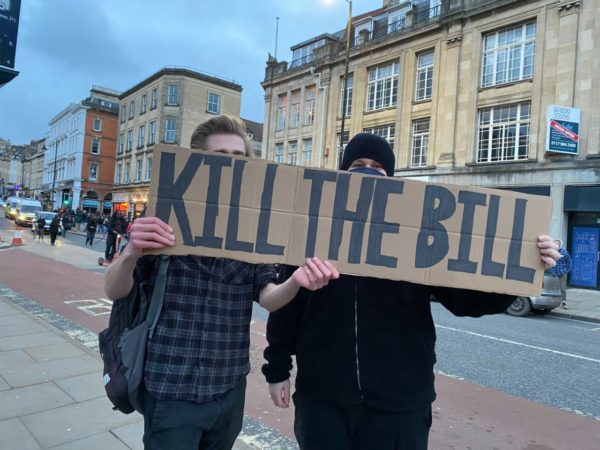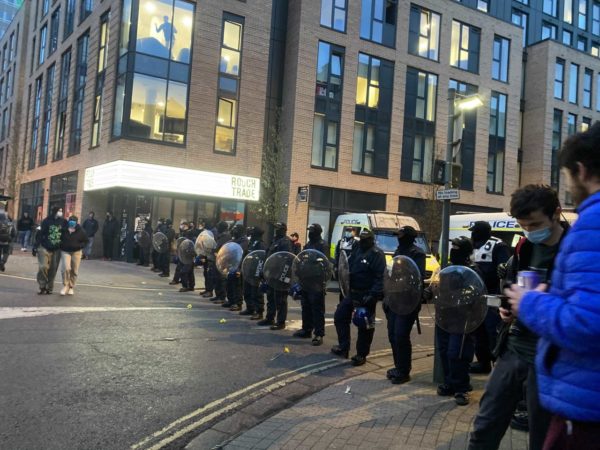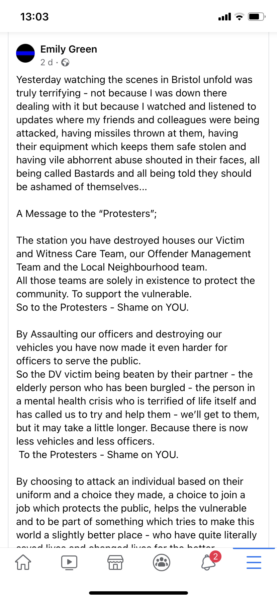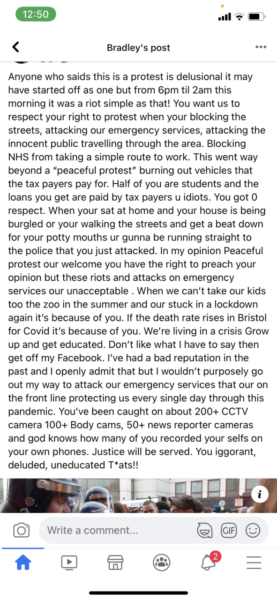According to the radical Counterfire website, demonstrations against the controversial Police, Crime, Sentencing and Courts Bill were supposed to take place in several East London locations last Saturday, including Walthamstow and Leytonstone. If they took place, Rising East has found no reports of them so far, but to give a personal insight into these nationwide Kill The Bill protests, our reporter Mai Sow attended one further afield, in Bristol, and shares her impressions below.
I had to get walk a long way from my cab to the march because protestors had blocked the roads, causing extensive traffic. I then marched from College Green to Rupert Street with around 1000 others chanting “Kill the bill!” and “Whose street? Our street!”

Although everything was pretty peaceful there were around five lines of riot police in city centre blocking roads and police vans everywhere, as well as police helicopters flying around. Although the protestors were peaceful, they were verbally abusing police officers. I could see anger in some of the protestors’ faces, though a lot of them had their faces covered so as to be anonymous.
The first one I asked to speak to said no because he didn’t want to be recognised, but another protestor told me, “The UK and a lot of the world is gradually sliding into a more authoritarian, more racist and fascist society. We must stand together and stop it”. He was holding a sign that said #freeSiyadanda. Supporters of Siyanda Mngaza claim she has been wrongfully jailed for grievous bodily harm when she was in fact defending herself from a racist attack.
As we neared the city centre we found a line of riot police blocking the road to the police station, so protestors sat down on the floor while some stayed standing, many of them with bottles of beer in their hands. A lot of journalists were positioned between the protestors and the riot police.

I left this area and walked towards the Haymarket where another group of protestors were chanting “Kill the bill.” They were blocking cars from passing and one of them attacked a car by hitting the windscreen with his hand. But before he could cause any real damage a few police officers ran up to stop him.
Despite the pouring rain some people were jamming to music and drinking alcohol while others were actually protesting. I got the sense that a lot of the people there didn’t really know what they were protesting about – and were there for the fun of it.
By the time I left, the police were blocking so many roads that it took a long time to get beyond the crowds. At that time the march was still peaceful, but social media soon told me that things had got out of hand.
Watching the videos on Twitter and elsewhere it is clear that the police used force. Daily Mail journalist Matthew Dresch for example posted a film in which he is clearly barged out of the way. In the caption he writes that the police “assaulted” him when he was “respectfully observing what was happening.” But elsewhere it is also clear that the police had bottles and bricks thrown at them.
I spoke to few people who attended the protest afterwards. Saywa Akakendelwa was clear that, “…the violence started after the police started to aggravate protestors.” But online you can also find posts by police officers that give a different point of view. In the post below Emily Green accuses the protestors of shouting “abhorrent abuse” at officers as well as throwing things at them, and of damaging the property of teams that are there to support the community.

Elsewhere there was condemnation from the public. Bradley below does not mince his words when he calls the protestors, “ignorant deluded uneducated t*ats.”

From what I saw things were always going to escalate. By blocking off so many roads, and by refusing to co-operate at all, the police were asking for a face-off and I knew the inevitable was going happen.



